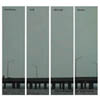 The next addition to in increasing collection of music by thesefantastically driven sonic players (see: Trapist, Radian, Dean Roberts)marries some of the free jazz tendencies with an affinity for retronoisemaking devices. Whereas the Trapist album reviewed last week wouldappeal to a number of Talk Talk fans, this album will probably find awarm place in the heart of many Wolf Eyes fans. While the liner notesdescribe the process of recording with respect to a room's atmosphereand space, my own mental image of the record is quite different. I seea very alien world. A world where the physical laws of nature that wehave grown accustomed to on this planet do not necessarily apply. Newcolors, new landscapes, and a new language, all of which are neitherdescribable nor translatable, but something which has to be experiencedfirst hand to truly appreciated. Recorded in 2001 and 2002, faintlytapped drum kits and timid guitars provide stability and recognitionwhile outbursts of analogue static and high frequency communicationlines blur the electromagnetism in the atmosphere. The planet and itscharacteristics are brilliantly established through "Part 1" and "Part2," while by "Part 3," actual beings are seemingly introduced. Like theutter bizzareness of the film Fantastic Planet,these foreign beings do not take recongnizable forms nor communicate inthe same way humans understand. It's on this track, "Part 3," whereit's almost as if a conversation is taking place between the aliens.Whether or not the quartet is imagining such a world during theirrecording is a different story, but the music created between themembers is very conversational, simply without words as we know them."Part 4" is much like a human contact would be to this new world. Thealien landscapes have been established but the guitar introducesitself, and at first, tries to mimic the electronic hums, drones andsqueals. As the contact between explorers and natives develops, eachtake turns in demonstrating what each species can do: the guitar andbass begin to play more familiar lines and between riffs, seems toalternate with the electronics for attention focus. This continues andescalates to the point of everybody playing together in a audio soup ofsorts, where everybody has let down their guard and has grown afondness for sharing themselves with new found friends. If Die InstabilitŠt der Symmetrieis like a visit to an alien world, the final track, "Part 5" is muchlike the sorrowful departure, as the melodies and tunes form in a veryconcluding manner, with low bass notes in a melancholy motion as thenew found friends must say goodbye, perhaps forever. The ship driftsoff into space as the whirry hums quell in the end. Fade to black. As aviewer to my own interpretation of the album as a fictitiousdocumentary, I hope the explorers and natives will meet up again someother day for another rewarding adventure.
The next addition to in increasing collection of music by thesefantastically driven sonic players (see: Trapist, Radian, Dean Roberts)marries some of the free jazz tendencies with an affinity for retronoisemaking devices. Whereas the Trapist album reviewed last week wouldappeal to a number of Talk Talk fans, this album will probably find awarm place in the heart of many Wolf Eyes fans. While the liner notesdescribe the process of recording with respect to a room's atmosphereand space, my own mental image of the record is quite different. I seea very alien world. A world where the physical laws of nature that wehave grown accustomed to on this planet do not necessarily apply. Newcolors, new landscapes, and a new language, all of which are neitherdescribable nor translatable, but something which has to be experiencedfirst hand to truly appreciated. Recorded in 2001 and 2002, faintlytapped drum kits and timid guitars provide stability and recognitionwhile outbursts of analogue static and high frequency communicationlines blur the electromagnetism in the atmosphere. The planet and itscharacteristics are brilliantly established through "Part 1" and "Part2," while by "Part 3," actual beings are seemingly introduced. Like theutter bizzareness of the film Fantastic Planet,these foreign beings do not take recongnizable forms nor communicate inthe same way humans understand. It's on this track, "Part 3," whereit's almost as if a conversation is taking place between the aliens.Whether or not the quartet is imagining such a world during theirrecording is a different story, but the music created between themembers is very conversational, simply without words as we know them."Part 4" is much like a human contact would be to this new world. Thealien landscapes have been established but the guitar introducesitself, and at first, tries to mimic the electronic hums, drones andsqueals. As the contact between explorers and natives develops, eachtake turns in demonstrating what each species can do: the guitar andbass begin to play more familiar lines and between riffs, seems toalternate with the electronics for attention focus. This continues andescalates to the point of everybody playing together in a audio soup ofsorts, where everybody has let down their guard and has grown afondness for sharing themselves with new found friends. If Die InstabilitŠt der Symmetrieis like a visit to an alien world, the final track, "Part 5" is muchlike the sorrowful departure, as the melodies and tunes form in a veryconcluding manner, with low bass notes in a melancholy motion as thenew found friends must say goodbye, perhaps forever. The ship driftsoff into space as the whirry hums quell in the end. Fade to black. As aviewer to my own interpretation of the album as a fictitiousdocumentary, I hope the explorers and natives will meet up again someother day for another rewarding adventure.samples:
Read More

